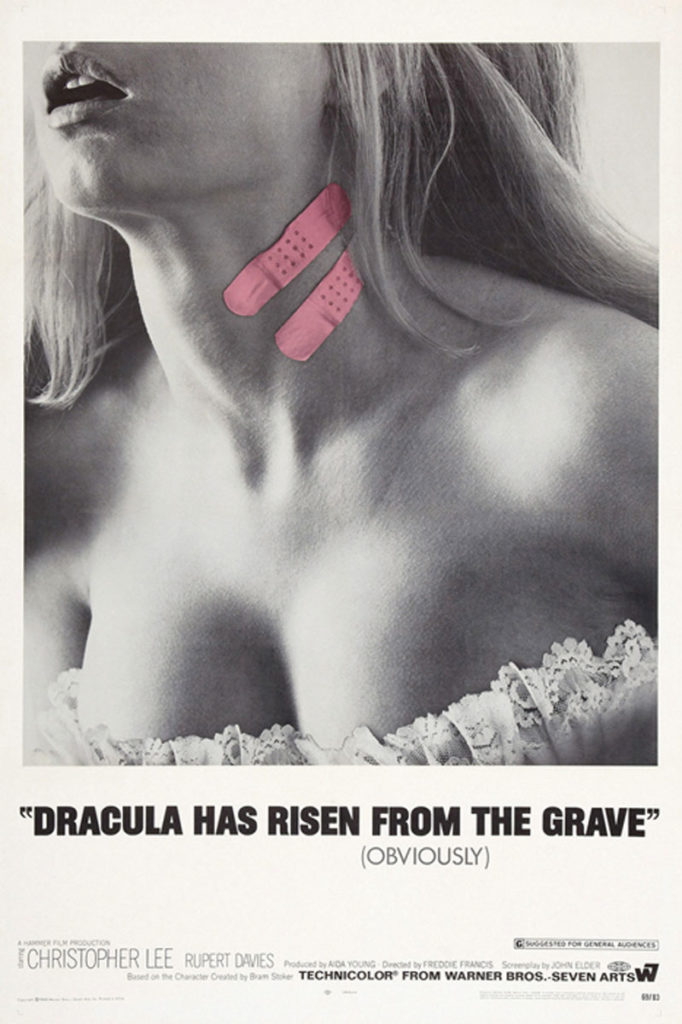It is now the halfway point of this year’s Horrorshow, and I’m enjoying watching all these classic Hammer horror flicks. But, watching them all close together like this means I’m more aware of when they are repeating themselves compared to watching them on a normal release schedule. For example, the three Mummy flicks I’ve reviewed so far this month have basically been the same film. There is still a good film to be made from the idea, but by The Mummy’s Shroud, I’m not sure the filmmakers were trying. Today’s film, Dracula Has Risen from the Grave, suffers from some of the same sort of creative malaise that doomed The Mummy’s Shroud.
Directed by Freddie Francis, who helmed The Evil of Frankenstein, and won a pair of Oscars for his cinematography on other films, Dracula Has Risen from the Grave has comparable technical sophistication to an episode of network television from the period. The makeup and effects are bad, and so are the sets. The sets are the correct style for a Hammer flick, but everything looks like it was made from bakelite, including outdoor sets. It’s an imitation of an imitation — rote where earlier Hammer films showed greater care. And, for having an Oscar winning cinematography in the director’s chair, the photography can best be described as weak. There are multiple sequences in this film that take place outdoors at night, but which were clearly shot during the day. Many, many films have tried to get away with this type of subterfuge, including greats like Apocalypse Now, but Francis and company barely make an effort to pass off these shots as nighttime.
There is also clumsy sexual innuendo scattered throughout, the mark of a film company that maybe had been struggling somewhat with its finances, shoving in some bosoms in the hope such luridness would provide a boost at the box office. But it’s a fruitless attempt at erotica, made even more laughable by the fact Dracula’s bite marks look like tiny nipples.
There is so much about this film that is ridiculous and cheap. Cheap is not a problem when combined with honest effort, but this production never feels like anything other than a cash grab.
There is a story I haven’t touched  on, yet. The film was written by Anthony Hinds, the producer son of Hammer’s founder, who seemed to have a hand in every Hammer horror film. He went by pseudonym in the credits, but the internet tells me it was Hinds that wrote this film, and when has the internet ever lied?
on, yet. The film was written by Anthony Hinds, the producer son of Hammer’s founder, who seemed to have a hand in every Hammer horror film. He went by pseudonym in the credits, but the internet tells me it was Hinds that wrote this film, and when has the internet ever lied?
Dracula (Christopher Lee) is dead, having drowned in his moat some months before. But his evil still permeates Castle Dracula and the surrounding lands, to the point that even the local church has been forsaken by priest and parishioners alike.
Monsignor Ernest Muller (Rupert Davies) arrives on the scene to set things right. He trudges up the side of a mountain to the forlorn castle (which seems to be placed on an ever higher mountain with each successive film), and performs the ritual of exorcism to banish the evil that still troubles the land. He dragged along the local parish priest (Ewan Hooper) to assist in the task, but he got cold feet halfway up the mountain and left the monsignor to his own devices. While traveling back down the mountain, the priest stumbles and falls into a small valley, where he lands on top of a block of ice containing the frozen body of…Dracula!
The priest was wounded and some of his blood drips onto Dracula and…voila! Resurrection. It’s not the worst resurrection I’ve ever seen in a horror flick, but it certainly is low effort.
Afterwards Dracula does what Dracula does. He terrorizes people and chases down a fair maiden to be his bride. There’s no reason to get any deeper into the plot because it’s largely identical to the other Dracula films featuring Lee. That’s not a bad thing. Originality isn’t necessary to make a successful film, although it helps. Combined with the poor showing from the production, a little originality in the plot would have worked wonders. As it is, Hinds’ screenplay is somewhat lost amid the cheapness.
But there is a strong ray of light in this film, as it were. Of the three Dracula performances up to this point, this was Lee’s best. In the first film, he was a polished gentleman, light on his feet and showing little indication of the evil lurking therein. In Dracula: Prince of Darkness, Dracula was a silent killer, Lee speaking no lines in the entire film. He does speak in this film (thank goodness), but his words are sparing. Dracula is a monster — something no longer human. Vlad Dracul died when he became a vampire, with this evil thing occupying his corpse, as played by Lee. He is like a spider that is pretending to be a man. Lee does more to save this film from the trash heap than anyone else involved. In fact, collectively, the cast did a good job, but Lee carried this film. It is good because of him, in spite of everything else that Francis and company did wrong.
